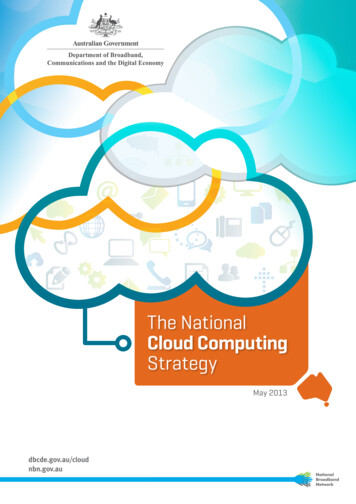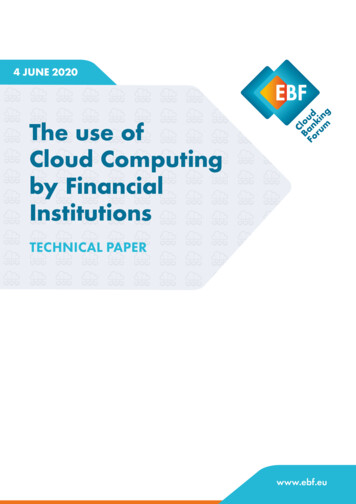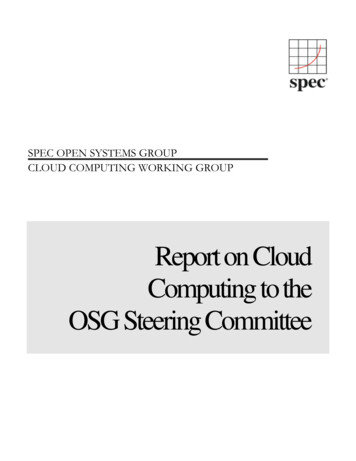
Transcription
The NationalCloud ComputingStrategyMay 2013dbcde.gov.au/cloudnbn.gov.au
Commonwealth of Australia 2013The material in this paper is licensed under a Creative Commons Attribution—3.0 Australia license, with the exception of: the Commonwealth Coat of Arms this department’s logo.More information on this CC BY license is set out at www.creativecommons.org/licenses/by/3.0/au/ Enquiries about thislicense and any use of this paper can be sent to GPO Box 2154, Canberra, ACT, 2601.AttributionUse of all or part of this paper must include the following attribution: Commonwealth of Australia 2013Using the Commonwealth Coat of ArmsThe terms of use for the Coat of Arms are available from the It’s an Honour website(see www.itsanhonour.gov.au and click ‘Commonwealth Coat of Arms’).
ContentsEXECUTIVE SUMMARY . . . . . . . . . . . . . . . . . . . . . . . . . . . . . . . . . . . . . . . . . . . . . . . . . 31. Maximising the value of cloud computing in government . . . . . . . . . . . . . . . . . . . . . . . . . . . . . 42. Promoting cloud computing to small businesses,not-for-profits and consumers . . . . . . . . . . . . . . . . . . . . . . . . . . . . . . . . . . . . . . . . . . . . . . . . . . . . . . . 43. Supporting a vibrant cloud services sector . . . . . . . . . . . . . . . . . . . . . . . . . . . . . . . . . . . . . . . . . . 5INTRODUCTION . . . . . . . . . . . . . . . . . . . . . . . . . . . . . . . . . . . . . . . . . . . . . . . . . . . . . . . . 7Different clouds for different needs . . . . . . . . . . . . . . . . . . . . . . . . . . . . . . . . . . . . . . . . . . . . . . . . . . . 9Benefits and risks of cloud computing . . . . . . . . . . . . . . . . . . . . . . . . . . . . . . . . . . . . . . . . . . . . . . . . 9The role of the Australian Government . . . . . . . . . . . . . . . . . . . . . . . . . . . . . . . . . . . . . . . . . . . . . . . 12MAXIMISING THE VALUE OF CLOUD COMPUTING IN GOVERNMENT . . . . . . 141. Helping government agencies adopt cloud services . . . . . . . . . . . . . . . . . . . . . . . . . . . . . . . 152. Value first through cloud services . . . . . . . . . . . . . . . . . . . . . . . . . . . . . . . . . . . . . . . . . . . . . . . . 17PROMOTING CLOUD COMPUTING TO SMALL BUSINESSES,NOT-FOR-PROFITS AND CONSUMERS . . . . . . . . . . . . . . . . . . . . . . . . . . . . . . . . 20Adoption of cloud services by small organisations to date . . . . . . . . . . . . . . . . . . . . . . . . . . . . . 211. A comprehensive suite of tools and online resources . . . . . . . . . . . . . . . . . . . . . . . . . . . . . . . 222. Consumer protection and effective law . . . . . . . . . . . . . . . . . . . . . . . . . . . . . . . . . . . . . . . . . . . 233. Enhancing existing successes . . . . . . . . . . . . . . . . . . . . . . . . . . . . . . . . . . . . . . . . . . . . . . . . . . . . 24SUPPORTING A VIBRANT CLOUD SERVICES SECTOR . . . . . . . . . . . . . . . . . . . 261. ICT skills and capacity . . . . . . . . . . . . . . . . . . . . . . . . . . . . . . . . . . . . . . . . . . . . . . . . . . . . . . . . . . . 262. Promoting competition, growth and foreign investment . . . . . . . . . . . . . . . . . . . . . . . . . . . 273. Supporting research and development . . . . . . . . . . . . . . . . . . . . . . . . . . . . . . . . . . . . . . . . . . . . 29ATTACHMENT: LIST OF GOALS AND ACTIONS . . . . . . . . . . . . . . . . . . . . . . . . . . 31Maximising the value of cloud computing in government: . . . . . . . . . . . . . . . . . . . . . . . . . . . . . 31Promoting cloud computing to small businesses,not-for-profits and consumers: . . . . . . . . . . . . . . . . . . . . . . . . . . . . . . . . . . . . . . . . . . . . . . . . . . . . . . 32Supporting a vibrant cloud services sector: . . . . . . . . . . . . . . . . . . . . . . . . . . . . . . . . . . . . . . . . . . . 33
Executive summaryOn 5 October 2012 the Prime Minister announced that the Australian Government would developa National Cloud Computing Strategy. This announcement recognised the synergies between theNational Broadband Network (NBN) and cloud computing, but also the important role for governmentin providing the tools that small business, individuals and government agencies need to realise thepromise of cloud computing. This strategy has been developed in a partnership between government,industry and consumer groups and outlines a vision for cloud computing in Australia:Australians will create and use world-class cloud services to boostinnovation and productivity across the digital economy.When organisations adopt cloud services, they are generally more productive, innovate better andoperate with greater agility. As a nation, Australia is well placed to take advantage of cloud computingfor a range of reasons—including a stable socio-economic system, a strong rule of law, and a highlydiverse and skilled Information and Communications Technology (ICT) sector.At the individual level there are many organisations across the economy that have implementedinnovative cloud computing services that have transformed the way they operate. However, as agroup, Australian small business and not-for-profit organisations lag behind their counterparts inOrganisation for Economic Co-operation and Development (OECD) countries in the use of onlinetechnology. This places these organisations at a competitive disadvantage, which could be overcomethrough the use of cloud computing services.One reason for this has been insufficient access to the necessary infrastructure to supportsophisticated cloud services—the relatively slow download or upload speeds in many parts ofAustralia have limited the adoption of cloud services. The NBN is changing this and is a key enablerof the digital economy more broadly. There are other reasons that cloud computing has not beenadopted more generally in Australia, including a lack of awareness of how to make best use of cloudcomputing and a lack of confidence that some organisations and individuals have in adopting cloudcomputing services.This strategy has identified three core goals and a set of actions to achieve the government’s vision.However, as the cloud services market continues to evolve, users and providers of cloud servicesmust remain responsive to change. Likewise, the government will continue to adapt its strategy inresponse to market and technological changes.National Cloud Computing Strategy 3
EXECUTIVE SUMMARY1. Maximising the value of cloud computing in governmentGoal: The Australian Government will be a leader in the use of cloud services to achieve greaterefficiency, generate greater value from ICT investment, deliver better services and support a moreagile public sector.Key actions: The Australian Government Information Management Office (AGIMO) will enhance the guidanceavailable to government decision makers on how to evaluate the benefits of cloud services and howto procure and manage them. AGIMO and the Department of Broadband, Communications and the Digital Economy (DBCDE) willestablish information sharing initiatives to facilitate continual improvement based on a repositoryof case studies, better practice risk approaches and practical lessons to enable agencies to learnfrom each other. The Department of Finance and Deregulation (DOFD) will enhance procurement practicesto ensure that government agencies are required to consider public cloud services for newICT procurements. Government agencies will transition public-facing websites to public cloud services as their refreshcycle allows, where those services represent the best value for money. The government will develop a business case by the end of 2013 to analyse the benefits anddrawbacks of a more centralised approach to the provision of cloud services to Australiangovernment agencies.2. Promoting cloud computing to small businesses,not-for-profits and consumersGoal: Australian small businesses, not-for-profit organisations and consumers will have theprotection and tools they need to acquire cloud services with confidence.Key actions: DBCDE and the Department of Industry, Innovation, Climate Change, Science, Research andTertiary Education (DIICCSRTE) will jointly:–– work with intermediaries and member associations to promote informed decision making aboutcloud computing and tailor information to the needs of particular industry segments–– enhance the online information available to small business and not-for-profit organisations aboutthe use of cloud services–– enhance the existing successes of the Digital Enterprise, Enterprise Connect, Technologyand Knowledge Connect, the Digital Local Government and Small Business AdvisoryService programs.4 National Cloud Computing Strategy
The Australian Computer Society will co-ordinate with the National Standing Committee on CloudComputing (NSCCC), the Australian Information Industry Association and other government andindustry stakeholders to develop a voluntary Cloud Consumer Protocol to encourage informationdisclosure by cloud providers and support consumers of cloud services in being well informed. DBCDE and the Office of the Australian Information Commissioner (OAIC) will publish guidance forthe cloud services industry about the new privacy reforms that are due to commence in March 2014.3. Supporting a vibrant cloud services sectorGoal: Australia will have a vibrant cloud sector supported by: a skilled and cloud-aware ICT workforce, able to create as well as adopt cloud services effective competition in cloud services regulatory settings that support growth, foster innovation and protect users.Key actions: The government will continue to work in close collaboration with industry and tertiary institutions toensure the development of skilled and cloud-aware ICT professionals. Austrade will work in partnership with industry to promote Australia as a trusted hub for datastorage and processing, and will encourage foreign investment and participation. DBCDE will continue to engage through the NSCCC to examine ad hoc cloud computing issues,opportunities and challenges.National Cloud Computing Strategy 5
· Promote benefits and debunk myths· Share lessons on successes andfailures· Measure progress· Improve procurement practices· Empower agencies with tools toassess benefits and risks· Work with trusted organisations· Drive cultural changeReview, assess and adjust· Measure progress· Provide tools that support gooddecision makingACTIONSPromoting cloudcomputing to smallbusinesses,not-for-profitsand consumersACTIONSMaximising the valueof cloud computingin GovernmentGOALGOALSupporting avibrant cloudservices sectorGOAL· Measure progress· Support regulatory certainty· Encourage competition andinvestment· Promote Australia as a trustedcloud hubACTIONSAustralians will create and use world class cloud services toboost innovation and productivity across the digital economy.The National Cloud Computing Strategy
IntroductionIn earlier years, businesses generated their own electricity to power individual factories. Electricitygeneration was costly and required specialist skills which not all businesses could afford. The rolloutof electricity grid infrastructure enabled electricity to be delivered as a utility, which in turn allowedbusinesses to consume electricity as a service. The centralisation of electricity generation allowed forgreater efficiencies, which meant that more businesses and even individuals could afford electricityby only paying for what they used. This evolution delivered transformational productivity gains acrossall segments of industrialised economies, improved the quality of life in communities and createdopportunities for new industries.Information and Communications Technology (ICT) is undergoing a similar evolution. For manydecades, public and private sector organisations and individuals have consumed ICT as a product byinvesting in onsite computer hardware and software. However, high-speed broadband infrastructure isenabling the consumption of ICT over the internet as a service.This new way of delivering ICT services has evolved rapidly over the past decade and has cometo be called cloud computing. Like widespread access and use of electricity, cloud computing is apotentially disruptive and transformative innovation. The term ‘cloud’ refers to the fact that a userof a service no longer needs to buy, build, install and operate expensive computer hardware. Userssimply access computing resources as a utility service via a ubiquitously available wired or wirelessnetwork—from ‘the cloud’. Figure 1 illustrates five important qualities that differentiate cloud servicesfrom traditional ICTi:Figure 1: Qualities of cloud servicesScalabilityUsers can scale up ordown cloud servicesquickly and cheaplyDevice agnosticResource poolingUsers can access cloudservices over a network througha broad range of devicesShared computing resoures canprovide significant economiesof scale which help reducecosts and accelerate innovationCapacity on demandMeteringUsers can measure theirconsumption of cloudservices quickly and easily,and adjust accordinglyThe service already existsand can be provisioned whenneeded, usually throughself-service interfaces. Thisin turn allows organisations torationalise their legacy ICTNational Cloud Computing Strategy 7
INTRODUCTIONCloud computing is already a major part of many people’s lives. Services such as Google Maps,Apple iTunes, Amazon Web Services and Microsoft’s Hotmail are taken for granted as simple andconvenient ways to access sophisticated computer systems. As these examples demonstrate, cloudcomputing services can be used to deliver a wide range of services to users and have been in usefor many years. Table 1 provides examples of three main categories of cloud services. In practice,virtually all types of computer systems and applications are now available as cloud services. Someof the more mature cloud services, such as Salesforce, have been operating for over a decade.Table 1—Example of cloud servicesInfrastructurePlatformSoftwareData storageOperating systemEmail and Word ProcessingProcessing powerWeb serversHuman Resource ManagementServer virtualisationDevelopment platformsCustomer RelationshipManagement (CRM)Irrespective of the type of cloud service, there are different deployment options available. The typeof deployment used is an important consideration and can be influenced by different factors such asbusiness needs, security requirements and degree of control required. Table 2 provides an overviewof two deployment types.Table 2—Cloud deployment optionsCLOUDSERVICE TYPEDESCRIPTIONPublic CloudservicesA public cloud provides services to users over the internet. Infrastructure is shared, anddata can be located in different locations across the globe. Some of the most well-knownpublic cloud providers are Google, Amazon Web Services and Microsoft. Public cloudservices offer all of the characteristics referred to in Figure 1. Public cloud services areused by ordinary consumers and an increasingly large number of organisations.Private CloudservicesA private cloud supplies ICT services to an organisation or restricted group of organisationsover a dedicated network link. The private infrastructure can be located on site ormanaged through an external provider. While private cloud services are quite similar totraditional ICT, they can offer some of the benefits of public cloud services to a limiteddegree. Private cloud services can also have better latency than other options. Privatecloud services are typically used by large organisations that are able to generate someefficiencies of scale including government agencies, banks and insurance companies.Private and public cloud services are on either side of a continuum. Most large organisationswill consume a mix of different types of cloud services (sometimes referred to as ‘hybrid cloud’).“community cloud” is another type of cloud, which is particularly relevant to the public sector.Community cloud allows infrastructure to be shared by a range of agencies with common interests.A community cloud may have components of public and private cloud. In the context of this paper,the term “cloud services” may apply to private, public, community or hybrid approaches. However, ina strict definitional sense, only public cloud can realise all of the characteristics outlined in Figure 1.It is important to emphasise that the benefit and risk profiles of various cloud service models willnot remain static over time. As the cloud computing industry continues to evolve, so will the relativebenefits and risks.8 National Cloud Computing Strategy
Different clouds for different needsWhy cloud?The banking industry is dependent on ICT for its operations and delivering quality customer service.High technology costs for secure systems and under-utilised hardware are additional obstacles thatbanks commonly face. Pay-for-use cloud services can provide banks and other financial institutionsopportunities to reduce costs by utilising hardware more efficiently and can give them the ability toscale operations as needed.Over the past few years the Commonwealth Bank has progressively moved to identify and utilise public,hybrid and private cloud solutions. The Commonwealth Bank has taken a selective approach: it has gonethrough the process of matching the right cloud service to different information security environmentsacross its business. For example the Commonwealth Bank stores sensitive information in a private cloudto retain maximum control, but uses public cloud services to access, store and protect non-sensitiveinformation efficiently.Benefits so farThe use of cloud services by the Commonwealth Bank has: resulted in a halving of data storage costs produced 40 per cent savings in software services that have been migrated to the cloud reduced testing and development costs by 50 per cent.Take away messageThe use of cloud services by the Commonwealth Bank has demonstrated that there are opportunitiesto realise substantial benefits in very complex business environments by matching the right service toeach need.Benefits and risks of cloud computingBenefits and risks to individual organisationsThe adoption of cloud computing globally has been accelerating, which reflects the maturity of cloudservices on offer and the value proposition that cloud computing offers for an increasingly largenumber of organisations. This rapid growth has been highlighted by Ovum Research which forecaststhe global cloud services market will reach revenues of US 66 billion in 2016, with an annual growthrate of almost 30 per cent.Cloud computing enables many organisations to reduce costs and outsource support andmaintenance to providers that have lower marginal costs and better expertise. Cost savings areachieved through more efficient utilisation of infrastructure and by pooling demand for ICT servicesacross many customers to enable lower prices.National Cloud Computing Strategy 9
INTRODUCTIONCloud services are particularly attractive to Small and Medium sized Enterprises (SMEs), becausecloud services can allow SMEs to easily outsource ICT and focus on what they are good at: theirbusiness. The productivity and cost saving benefits of cloud services are becoming increasinglywell quantified. A 2011 study conducted by Microsoft surveyed over 3000 SMEs across 16 countries and foundthat firms which embraced cloud services had 40 per cent more revenue growth in the previousyear compared to those which had notii. A 2012 study commissioned by the European Union (EU) found that over 80 per cent ofenterprises surveyed had reduced ICT costs by 20 per cent through cloud servicesiii. These firmsalso reported improved productivity (40 per cent) and improved business processes (35 per cent).The adoption of cloud services had also significantly improved the agility of these businesses. Inaddition, 46 per cent of respondents to this survey reported they were more efficient and effectivein working from mobile devices in the field.Productivity improvements for small businesses will lead to benefits for Australian consumers. A 2012survey by Mind Your Own Business (MYOB) found that 33 per cent of SME respondents indicatedthey would be quite likely to pass on cost savings achieved through the adoption of cloud services totheir customersiv.Cloud computing can offer individual organisations many benefits in addition to productivityincreases. These include: Functionality: the economies of scale of cloud services mean that providers are able to makesignificant investments in the functionality of their products. This means that many cloud servicesprovide ‘best in class’ functions and features, superior to what any individual organisation couldordinarily afford on their own. Mobility: increased capacity to work from a mobile device is a key reason for some organisationsin acquiring cloud services. Cloud services have enabled a new wave of mobile applications andvirtualised work environments, accessible on any device, anywhere. Cloud computing supports amore flexible and agile workforce through teleworking and secure virtualised work environments. Scalability: cloud services enable an individual or company to access computer services on a payas-you-go basis, with the flexibility to scale up and down as needed for little marginal cost. Strong security: cloud service providers can offer small business better security, reliability andaccess to the latest upgrades than would otherwise have been possible through traditional inhouse solutions.However, these benefits can only be fully realised following an assessment of the relative benefitsand risks of any individual cloud service offering. All ICT has risk associated with it. For example,data stored at home is susceptible to theft or hardware failure. Cloud computing is not inherentlymore or less risky than traditional ICT, but the relative risks are different. Consultations and researchcommissioned by DBCDE have identified the following issues of vulnerability for small business andindividual consumersv:10 National Cloud Computing Strategy
Lack of quality information about the risks and benefits of cloud services: There is a significantamount of information available in the marketplace about cloud services. However, much of thisinformation can be difficult for consumers, small businesses and other organisations to understandor trust. Provision of information tailored to the specific needs of organisations can be a useful wayfor the government to assist in the efficient functioning of a marketplace which benefits suppliers,users and intermediaries. Data ownership, privacy and security: Consumers—including individuals and small businesses—should have full ownership of their personal and organisational data. Privacy and security risksremain a key issue for some individual consumers and small businesses. A recent MYOB surveyfound that 16 per cent of SMEs identified data ownership as a key concern inhibiting adoptionof cloud services. The industry has reacted to this concern to some extent. For example, somevendors allow users to specify the physical location of data stored. It is worth noting that theeconomy wide Privacy Act 1988 already obliges organisations (including cloud service providers)to deal with personal information appropriately (including where data is stored and processed injurisdictions outside of Australia). Vendor lock-in and interoperability: Lack of understanding ortransparency about the transfer of data from one provider toanother discourages consumers and small businesses fromadopting cloud services due to fears of vendor or serviceprovider lock-in. Data portability is a key mitigating strategyagainst vendor lock-in for cloud data storage services.Data liberation: Some vendorsare already taking stepsto improve interoperabilitybetween providers and reducevendor lock-in. Google’s product‘Takeout’ for example allowsusers to migrate their dataout of some Google productsand into the systems of othervendors, and vice versa. Unequal bargaining power: There is the potential forconsumers and small businesses to enter into contractswith cloud services providers without understanding thepotential risks. Since consumers and small businesses donot have the power to vary a cloud provider’s terms andconditions, some may not have the confidence to adoptcloud services. This is also potentially a problem of traditionalICT and many other services in the broader economy. Theeconomy-wide Australian Consumer Law already provides protections to users of cloud servicesand counteracts the impact of unequal bargaining power to some degree (see Schedule 2 of theCompetition and Consumer Act 2010). Loss of internet connectivity and availability of a quality connection: As small businesses integratemore business capabilities with cloud computing there is a greater need for reliable internetconnectivity. Downtime has the potential to have a negative impact on operations, similar to theloss of other services such as electricity or water. To a large extent the NBN will address this issue,but in addition there are options—for example the use of mobile broadband internet or accessinginternet services off-site in the event of a natural or man-made disaster—which can further mitigatesome risk.National Cloud Computing Strategy 11
INTRODUCTIONBenefits to the economy as a wholeThere is a stream of evidence highlighting the economic growth that cloud services promote: KPMG modelling shows the increased adoption of cloud services across the Australian economywould grow annual GDP by 3.3 billion by 2020vi. An EU study into the impact of cloud computing predicts that if all EU member countriessuccessfully adopted public cloud it would boost GDP by 1 per cent and create 2.5 million jobs by2020 vii. The study also reported that a scenario driven by government policy was three times moreeffective in creating jobs and economic growth compared to a scenario with no government policy. The International Data Corporation estimates that by 2015 cloud computing will, on a global level,create 14 million new jobs and USD 1.1 trillion a year in new business revenues. Research firm Forrester has projected public cloud services worth US 14.7 billion in 2010 willgenerate a six-fold increase in revenue for cloud vendors of 94.1 billion by 2015viii.Cloud computing can also help to reduce carbon emissions. A report commissioned by the CarbonDisclosure Project looking at data centre emissions found that large US companies can achieveannual energy savings of US 12.3 billion through the efficient server utilisation and resource poolingoffered by cloud infrastructureix.Research of this nature underscores the great potential for cloud services to boost economic growthand drive productivity across the Australian economy. At the same time there is clearly huge potentialat the individual firm level to create new business models, innovate, and reduce costs.The role of the Australian GovernmentThe benefits that broader adoption of cloud computing could offer the Australian economy arecompelling. This strategy was put together in close consultation with key stakeholders and aims toaddress barriers to adoption while maximising the benefits of cloud computing in Australia.Vision: Australians will create and use world-class cloud services toboost innovation and productivity across the digital economy.There are a number of initiatives already in place to help realise this vision. The government’sinvestment in the NBN will give all Australians the opportunity to engage in the digital economy,of which cloud computing is an important part.12 National Cloud Computing Strategy
There is more to do. Beyond the necessary upgrades to physical infrastructure, government has animportant role on a number of fronts: the government procures services. With an annual spend of around 5 billion on ICT, thegovernment has a role leading the adoption of cloud services where these services represent thebest value for money and management of risk. the government acts as a regulator to address market shortcomings. There is already economywide consumer protection and privacy regulation in Australia which applies to cloud services.The government does not consider there is any present need for cloud service specific regulation,but will closely monitor the cloud services market to ensure that Australians are able to take fulladvantage of cloud services. The government can address information asymmetries by developingand promoting information to allow individuals, small businesses and not-for-profit organisations tounderstand the relative benefits and risks of cloud computing compared to the benefits and risksof traditional ICT. the government can help ensure that the Australian cloud services industry is vibrant, and is in aposition to capitalise on Australia’s natural advantages, while encouraging foreign investment andparticipation. The government can foster strong links across research, vendor and the end-usercommunity to support the supply and creation of innovative, globally exportable cloud technology.This Strategy sets out the priorities, goals and actions that the government will take to fulfil its vision.National Cloud Computing Strategy 13
MAXIMISING the value of cloud computing in governmentMaximising the value of cloudcomputing in governmentMany stakeholders have identified the importance of the government’s own adoption of cloudservices as central to encouraging informed adoption more broadly. There are a number ofreasons for this: As a significant procurer of ICT services, there is a substantial flow-on effect from termsand products pr
Cloud Computing. Strategy . 3. Executive summary. On 5 October 2012 the Prime Minister announced that the Australian Government would develop a National Cloud Computing Strategy. This announcement recognised the synergies between the National Broadband Network (NBN) and cloud computing, but also the important role for government










